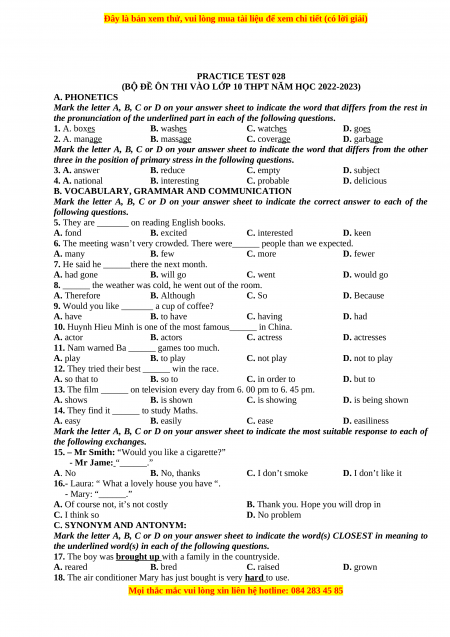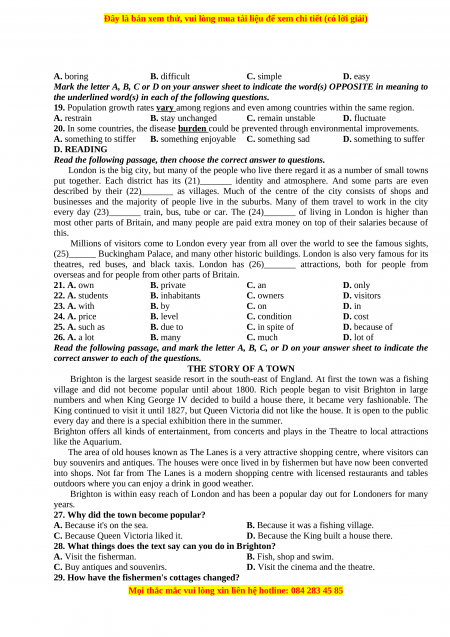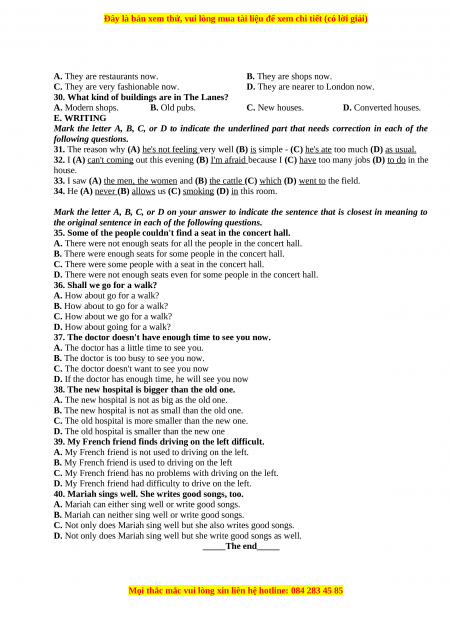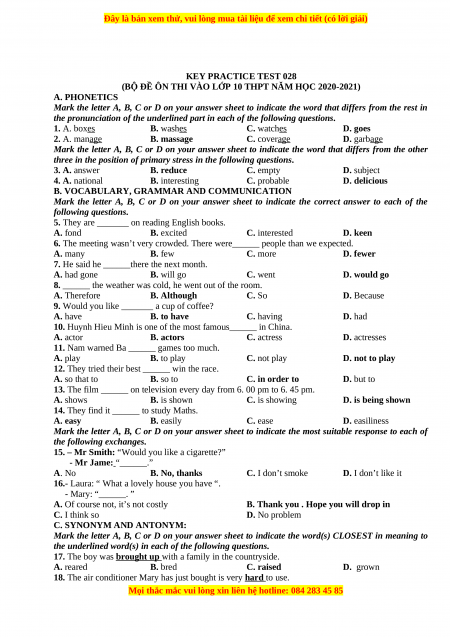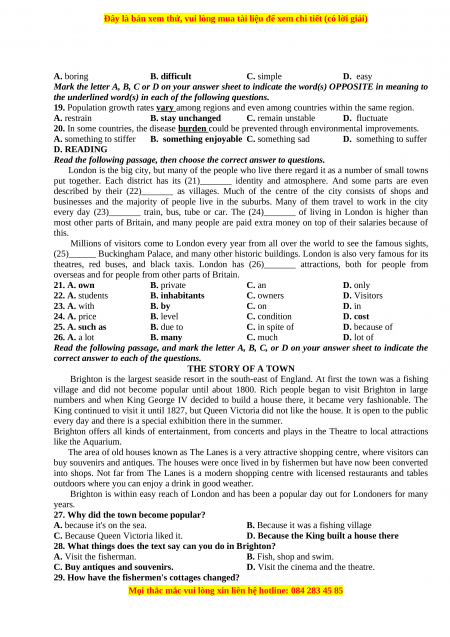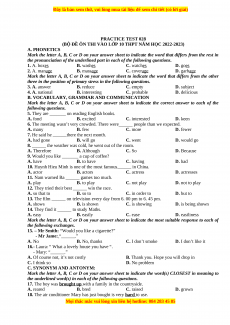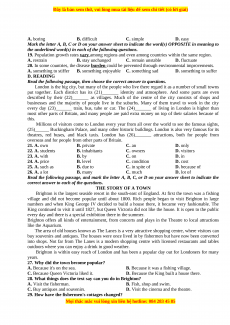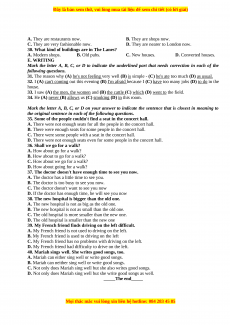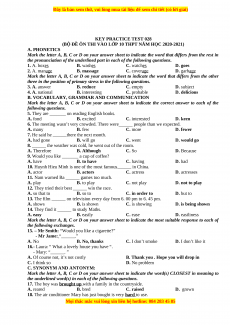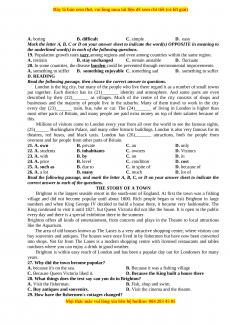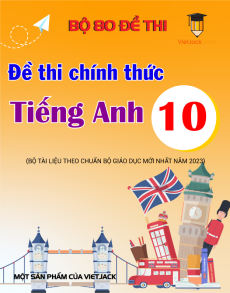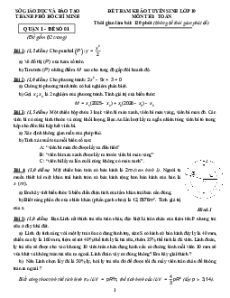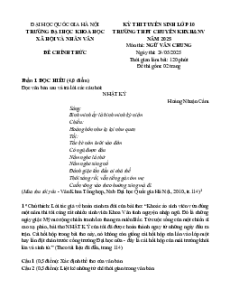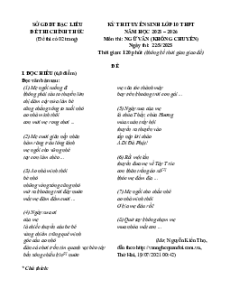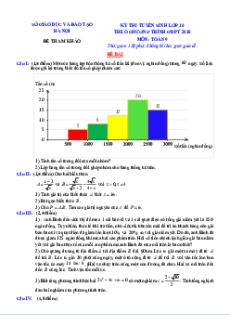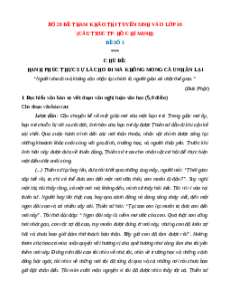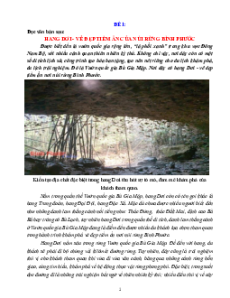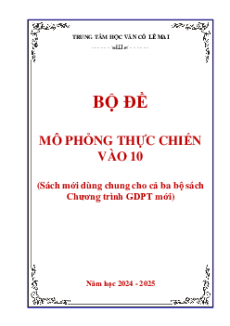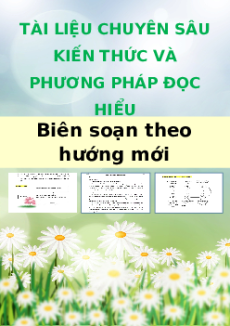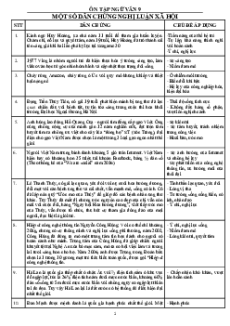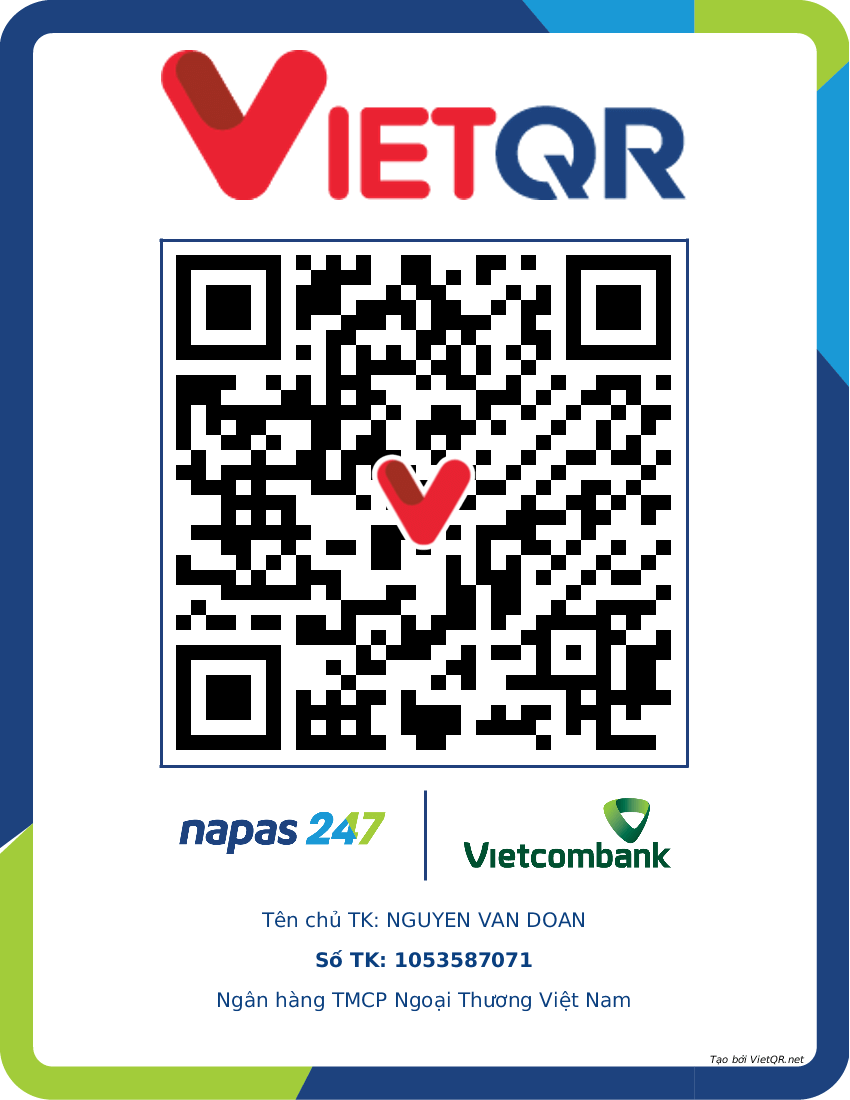PRACTICE TEST 028
(BỘ ĐỀ ÔN THI VÀO LỚP 10 THPT NĂM HỌC 2022-2023) A. PHONETICS
Mark the letter A, B, C or D on your answer sheet to indicate the word that differs from the rest in
the pronunciation of the underlined part in each of the following questions. 1. A. boxes B. washes C. watches D. goes 2. A. manage B. massage C. coverage D. garbage
Mark the letter A, B, C or D on your answer sheet to indicate the word that differs from the other
three in the position of primary stress in the following questions. 3. A. answer B. reduce C. empty D. subject 4. A. national B. interesting C. probable D. delicious
B. VOCABULARY, GRAMMAR AND COMMUNICATION
Mark the letter A, B, C or D on your answer sheet to indicate the correct answer to each of the following questions.
5. They are _______ on reading English books. A. fond B. excited C. interested D. keen
6. The meeting wasn’t very crowded. There were______ people than we expected. A. many B. few C. more D. fewer
7. He said he ______there the next month. A. had gone B. will go C. went D. would go
8. ______ the weather was cold, he went out of the room. A. Therefore B. Although C. So D. Because
9. Would you like _______ a cup of coffee? A. have B. to have C. having D. had
10. Huynh Hieu Minh is one of the most famous______ in China. A. actor B. actors C. actress D. actresses
11. Nam warned Ba ______ games too much. A. play B. to play C. not play D. not to play
12. They tried their best ______ win the race. A. so that to B. so to C. in order to D. but to
13. The film ______ on television every day from 6. 00 pm to 6. 45 pm. A. shows B. is shown C. is showing D. is being shown
14. They find it ______ to study Maths. A. easy B. easily C. ease D. easiliness
Mark the letter A, B, C or D on your answer sheet to indicate the most suitable response to each of the following exchanges.
15. – Mr Smith: “Would you like a cigarette?”
- Mr Jame: “______.” A. No B. No, thanks C. I don’t smoke D. I don’t like it
16.- Laura: “ What a lovely house you have “. - Mary: “______.”
A. Of course not, it’s not costly
B. Thank you. Hope you will drop in C. I think so D. No problem C. SYNONYM AND ANTONYM:
Mark the letter A, B, C or D on your answer sheet to indicate the word(s) CLOSEST in meaning to
the underlined word(s) in each of the following questions.
17. The boy was b
rought up with a family in the countryside. A. reared B. bred C. raised D. grown
18. The air conditioner Mary has just bought is very h ard to use.
A. boring B. difficult C. simple D. easy
Mark the letter A, B, C or D on your answer sheet to indicate the word(s) OPPOSITE in meaning to
the underlined word(s) in each of the following questions.
19. Population growth rates var
y among regions and even among countries within the same region. A. restrain B. stay unchanged C. remain unstable D. fluctuate
20. In some countries, the disease b
urden could be prevented through environmental improvements. A. something to stiffer B. something enjoyable C. something sad D. something to suffer D. READING
Read the following passage, then choose the correct answer to questions.
London is the big city, but many of the people who live there regard it as a number of small towns
put together. Each district has its (21)_______ identity and atmosphere. And some parts are even
described by their (22)_______ as villages. Much of the centre of the city consists of shops and
businesses and the majority of people live in the suburbs. Many of them travel to work in the city
every day (23)_______ train, bus, tube or car. The (24)_______ of living in London is higher than
most other parts of Britain, and many people are paid extra money on top of their salaries because of this.
Millions of visitors come to London every year from all over the world to see the famous sights,
(25)______ Buckingham Palace, and many other historic buildings. London is also very famous for its
theatres, red buses, and black taxis. London has (26)_______ attractions, both for people from
overseas and for people from other parts of Britain. 21. A. own B. private C. an D. only 22. A. students B. inhabitants C. owners D. visitors 23. A. with B. by C. on D. in 24. A. price B. level C. condition D. cost 25. A. such as B. due to C. in spite of D. because of 26. A. a lot B. many C. much D. lot of
Read the following passage, and mark the letter A, B, C, or D on your answer sheet to indicate the
correct answer to each of the questions. THE STORY OF A TOWN
Brighton is the largest seaside resort in the south-east of England. At first the town was a fishing
village and did not become popular until about 1800. Rich people began to visit Brighton in large
numbers and when King George IV decided to build a house there, it became very fashionable. The
King continued to visit it until 1827, but Queen Victoria did not like the house. It is open to the public
every day and there is a special exhibition there in the summer.
Brighton offers all kinds of entertainment, from concerts and plays in the Theatre to local attractions like the Aquarium.
The area of old houses known as The Lanes is a very attractive shopping centre, where visitors can
buy souvenirs and antiques. The houses were once lived in by fishermen but have now been converted
into shops. Not far from The Lanes is a modern shopping centre with licensed restaurants and tables
outdoors where you can enjoy a drink in good weather.
Brighton is within easy reach of London and has been a popular day out for Londoners for many years.
27. Why did the town become popular?
A. Because it's on the sea.
B. Because it was a fishing village.
C. Because Queen Victoria liked it.
D. Because the King built a house there.
28. What things does the text say can you do in Brighton? A. Visit the fisherman. B. Fish, shop and swim.
C. Buy antiques and souvenirs.
D. Visit the cinema and the theatre.
29. How have the fishermen's cottages changed?
A. They are restaurants now. B. They are shops now.
C. They are very fashionable now.
D. They are nearer to London now.
30. What kind of buildings are in The Lanes? A. Modern shops. B. Old pubs. C. New houses. D. Converted houses. E. WRITING
Mark the letter A, B, C, or D to indicate the underlined part that needs correction in each of the following questions.
31. The reason why (A) he's not feeling very well (B) is simple - (C) he's ate too much (D) as usual.
32. I (A) can't coming out this evening (B) I'm afraid because I (C) have too many jobs (D) to do in the house.
33. I saw (A) the men, the women and (B) the cattle (C) which (D) went to the field.
34. He (A) never (B) allows us (C) smoking (D) in this room.
Mark the letter A, B, C, or D on your answer to indicate the sentence that is closest in meaning to
the original sentence in each of the following questions.
35. Some of the people couldn't find a seat in the concert hall.
A. There were not enough seats for all the people in the concert hall.
B. There were enough seats for some people in the concert hall.
C. There were some people with a seat in the concert hall.
D. There were not enough seats even for some people in the concert hall. 36. Shall we go for a walk?
A. How about go for a walk?
B. How about to go for a walk?
C. How about we go for a walk?
D. How about going for a walk?
37. The doctor doesn't have enough time to see you now.
A. The doctor has a little time to see you.
B. The doctor is too busy to see you now.
C. The doctor doesn't want to see you now
D. If the doctor has enough time, he will see you now
38. The new hospital is bigger than the old one.
A. The new hospital is not as big as the old one.
B. The new hospital is not as small than the old one.
C. The old hospital is more smaller than the new one.
D. The old hospital is smaller than the new one
39. My French friend finds driving on the left difficult.
A. My French friend is not used to driving on the left.
B. My French friend is used to driving on the left
C. My French friend has no problems with driving on the left.
D. My French friend had difficulty to drive on the left.
40. Mariah sings well. She writes good songs, too.
A. Mariah can either sing well or write good songs.
B. Mariah can neither sing well or write good songs.
C. Not only does Mariah sing well but she also writes good songs.
D. Not only does Mariah sing well but she write good songs as well. _____The end_____
KEY PRACTICE TEST 028
(BỘ ĐỀ ÔN THI VÀO LỚP 10 THPT NĂM HỌC 2020-2021) A. PHONETICS
Mark the letter A, B, C or D on your answer sheet to indicate the word that differs from the rest in
the pronunciation of the underlined part in each of the following questions. 1. A. boxes B. washes C. watches D. goes 2. A. manage B. massage C. coverage D. garbage
Mark the letter A, B, C or D on your answer sheet to indicate the word that differs from the other
three in the position of primary stress in the following questions. 3. A. answer B. reduce C. empty D. subject 4. A. national B. interesting C. probable D. delicious
B. VOCABULARY, GRAMMAR AND COMMUNICATION
Mark the letter A, B, C or D on your answer sheet to indicate the correct answer to each of the following questions.
5. They are _______ on reading English books. A. fond B. excited C. interested D. keen
6. The meeting wasn’t very crowded. There were______ people than we expected. A. many B. few C. more D. fewer
7. He said he ______there the next month. A. had gone B. will go C. went D. would go
8. ______ the weather was cold, he went out of the room. A. Therefore B. Although C. So D. Because
9. Would you like _______ a cup of coffee? A. have B. to have C. having D. had
10. Huynh Hieu Minh is one of the most famous______ in China. A. actor B. actors C. actress D. actresses
11. Nam warned Ba ______ games too much. A. play B. to play C. not play D. not to play
12. They tried their best ______ win the race. A. so that to B. so to C. in order to D. but to
13. The film ______ on television every day from 6. 00 pm to 6. 45 pm. A. shows B. is shown C. is showing D. is being shown
14. They find it ______ to study Maths. A. easy B. easily C. ease D. easiliness
Mark the letter A, B, C or D on your answer sheet to indicate the most suitable response to each of the following exchanges.
15. – Mr Smith: “Would you like a cigarette?”
- Mr Jame: “______.” A. No B. No, thanks C. I don’t smoke D. I don’t like it
16.- Laura: “ What a lovely house you have “. - Mary: “______. ”
A. Of course not, it’s not costly
B. Thank you . Hope you will drop in C. I think so D. No problem C. SYNONYM AND ANTONYM:
Mark the letter A, B, C or D on your answer sheet to indicate the word(s) CLOSEST in meaning to
the underlined word(s) in each of the following questions.
17. The boy was b
rought up with a family in the countryside. A. reared B. bred C. raised D. grown
18. The air conditioner Mary has just bought is very h ard to use.
Đề luyện thi vào 10 môn Tiếng anh năm 2023 có đáp án (Đề 28)
1.5 K
763 lượt tải
MUA NGAY ĐỂ XEM TOÀN BỘ TÀI LIỆU
CÁCH MUA:
- B1: Gửi phí vào TK:
1133836868- CT TNHH DAU TU VA DV GD VIETJACK - Ngân hàng MB (QR) - B2: Nhắn tin tới Zalo VietJack Official ( nhấn vào đây ) để xác nhận thanh toán và tải tài liệu - giáo án
Liên hệ ngay Hotline hỗ trợ: 084 283 45 85
Đề thi được cập nhật liên tục trong gói này từ nay đến hết tháng 6/2023. Chúng tôi đảm bảo đủ số lượng đề đã cam kết hoặc có thể nhiều hơn, tất cả có BẢN WORD, LỜI GIẢI CHI TIẾT và tải về dễ dàng.
Để tải tài liệu gốc về máy bạn click vào nút Tải Xuống ở trên!
Thuộc bộ (mua theo bộ để tiết kiệm hơn):
- Tailieugiaovien.com.vn giới thiệu bộ 80 đề luyện thi vào 10 môn Tiếng anh mới nhất năm 2022 - 2023 nhằm giúp Giáo viên có thêm tài liệu tham khảo đề luyện thi Tiếng anh ôn luyện vào 10.
- File word có lời giải chi tiết 100%.
- Mua trọn bộ sẽ tiết kiệm hơn tải lẻ 50%.
Đánh giá
4.6 / 5(1525 )5
4
3
2
1
Trọng Bình
Tài liệu hay
Giúp ích cho tôi rất nhiều
Duy Trần
Tài liệu chuẩn
Rất thích tài liệu bên VJ soạn (bám sát chương trình dạy)
TÀI LIỆU BỘ BÁN CHẠY MÔN Tiếng Anh
Xem thêmTÀI LIỆU BỘ BÁN CHẠY Ôn vào 10
Xem thêmTài liệu bộ mới nhất

!"#$%#&$&'$()*
+,-./$0%12345 6($0 $/7809#)()):)();
"< 03/&$%#'
Mark the letter A, B, C or D on your answer sheet to indicate the word that differs from the rest in
the pronunciation of the underlined part in each of the following questions.
6< +< #< =<
)< +< #< =<
Mark the letter A, B, C or D on your answer sheet to indicate the word that differs from the other
three in the position of primary stress in the following questions.
;<"< +< #< =<
><"< +< #< =<
+<13#"+?4"!@A!"88"!"/=#388?/%#"$%3/
Mark the letter A, B, C or D on your answer sheet to indicate the correct answer to each of the
following questions.
B<
"< +< #< =<
C<
"< +< #< =<
D<
"< +< #< =<
*<!
"< +< #<" =<#
E<$%
"< +< #< =<
6(< &'
"< +< #< =<
66<(#
"< +< #< =<
6)<
"< +< #< =<
6;<)**)+,
"< +< #< =<
6><&
"< +< #< =<
Mark the letter A, B, C or D on your answer sheet to indicate the most suitable response to each of
the following exchanges.
6B<F8G'H-$%.
:8GIH-.
"( +<(! #</ =</
6C<:01-$-
:&1-.
"<2! +<
#</ =<(
#<'@/3/@8"/="/$3/@8H
Mark the letter A, B, C or D on your answer sheet to indicate the word(s) CLOSEST in meaning to
the underlined word(s) in each of the following questions.
6D<3GJK L
"< +< #< =<
6*<&3GM L
8NOOPJH(*>)*;>B*B

"< +< #< =<
Mark the letter A, B, C or D on your answer sheet to indicate the word(s) OPPOSITE in meaning to
the underlined word(s) in each of the following questions.
6E<43G L
"< +< #< =<
)(</!3GM L
"< +< #< =<
=<!&"=%/A
Read the following passage, then choose the correct answer to questions.
0!
5678
5668 &
&
5698!!56+80
#!
&0!
56,8#4!0
! ! 0 56)8 !
#
)6<"< +< #< =<
))<"< +< #< =<
);<"< +< #< =<
)><"< +< #< =<
)B<"< +< #< =<
)C<"< +< #< =<
Read the following passage, and mark the letter A, B, C, or D on your answer sheet to indicate the
correct answer to each of the questions.
$0&'$3!@3Q"$3R/
#:
7;**<#
=>/?!
=7;6@!A?/
#!
B
0!
B
(0
#00
)D<RMMJSJKJKGT
"<#C +<#
#<#A? =<#=
)*<RUMJUUJMJ+GJT
"<? +<D!
#<#B =<?
)E<0JSVUGWUJUMT
8NOOPJH(*>)*;>B*B

"< +<
#< =<0
;(<RXMJVMUG$4UT
"<& +<2 #<( =<'
&<R!%$%/A
Mark the letter A, B, C, or D to indicate the underlined part that needs correction in each of the
following questions.
;6<"C+:#C=
;)</"C+/C/#=
;;</"!+#=
;>< "+#=
Mark the letter A, B, C, or D on your answer to indicate the sentence that is closest in meaning to
the original sentence in each of the following questions.
;B<'JJVKJKJMWVMUJG<
"<
+<
#<
=<
;C<'SJVJGSXT
"< %
+< %
#< %
=< %
;D<$MJJGMJUWJJUJJS<
"<
+<
#<C
=</!
;*<$SJUKUGJMJ<
"<
+<
#<
=<
;E<8QGVGMVMUMGJVMVV<
"<&D
+<&D
#<&D
=<&D
>(<8GUUS<'SGUJJMUJUJJ<
"<&
+<&
#<(&
=<(&
YYYYY$MYYYYY
8NOOPJH(*>)*;>B*B

Z&@ !"#$%#&$&'$()*
+,-./$0%12345 6($0 $/7809#)()(:)()6
"< 03/&$%#'
Mark the letter A, B, C or D on your answer sheet to indicate the word that differs from the rest in
the pronunciation of the underlined part in each of the following questions.
6< +< #< =<JU
)< +<UU #< =<
Mark the letter A, B, C or D on your answer sheet to indicate the word that differs from the other
three in the position of primary stress in the following questions.
;<"< +<GM #< =<
><"< +< #< =<MJU
+<13#"+?4"!@A!"88"!"/=#388?/%#"$%3/
Mark the letter A, B, C or D on your answer sheet to indicate the correct answer to each of the
following questions.
B<
"< +< #< =<X
C<
"< +< #< =<VSG
D<
"< +< #< =<SJMJ
*<!
"< +<"J #<" =<#
E<$%
"< +<J #< =<
6(< &'
"< +<JGU #< =<
66<(#
"< +< #< =<JJK
6)<
"< +< #<JGMGJ =<
6;<)**)+,
"< +< #< =<UUJS
6><&
"<U +< #< =<
Mark the letter A, B, C or D on your answer sheet to indicate the most suitable response to each of
the following exchanges.
6B<F8G'H-$%.
:8GIH-.
"( +</JXU #</ =</
6C<:01-$-
:&1-.
"<2! +<$XJ<0JKJSMGJK
#</ =<(
#<'@/3/@8"/="/$3/@8H
Mark the letter A, B, C or D on your answer sheet to indicate the word(s) CLOSEST in meaning to
the underlined word(s) in each of the following questions.
6D<3GJK L
"< +< #<GUM =<L
6*<&3GM L
8NOOPJH(*>)*;>B*B

"< +<MVV #< =<L
Mark the letter A, B, C or D on your answer sheet to indicate the word(s) OPPOSITE in meaning to
the underlined word(s) in each of the following questions.
6E<43G L
"< +<UM #< =<L
)(</!3GM L
"< +<LUJ[J #< =<L
=<!&"=%/A
Read the following passage, then choose the correct answer to questions.
0!
5678
5668 &
&
5698!!56+80
#!
&0!
56,8#4!0
! ! 0 56)8 !
#
)6<"<JS +< #< =<
))<"< +<U #< =<?
);<"< +< #< =<
)><"< +< #< =<JU
)B<"<UU +< #< =<
)C<"< +< #< =<
Read the following passage, and mark the letter A, B, C, or D on your answer sheet to indicate the
correct answer to each of the questions.
$0&'$3!@3Q"$3R/
#:
7;**<#
=>/?!
=7;6@!A?/
#!
B
0!
B
(0
#00
)D<RMMJSJKJKGT
"<C +<#
#<#A? =<+UZJUG
)*<RUMJUUJMJ+GJT
"<? +<D!
#<+\UMUJGU< =<?
)E<0JSVUGWUJUMT
8NOOPJH(*>)*;>B*B
